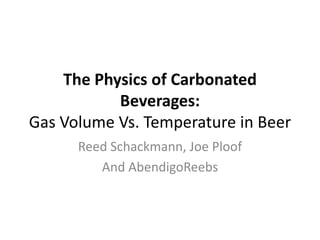
Beer physics
- 1. The Physics of Carbonated Beverages: Gas Volume Vs. Temperature in Beer Reed Schackmann, Joe Ploof And AbendigoReebs
- 2. Introduction At first, we wanted to conduct an experiment with beer using Henry’s Law, but quickly realized it would be difficult to measure partial pressures and gas solubility in liquid So we thought about our experiences with regards to temperature and gas volume in beer
- 3. Observations about The Physics of Beer Beer kegs can explode, if they get too warm or get shaken, as well as bottles of beer upon opening Warm beer tastes bad and isn’t nearly as refreshing The sound that you hear when you twist off the cap is carbon dioxide leaving the bottle, as gas molecules push their way out
- 4. General Observation A Change in Temperature Seems to Correspond with a Change in the Amount of Carbon Dioxide Gas When we increase the temp on a confined gas, the kinetic energy of the gas molecules increases, causing their overall volume to expand Source: Myers, Rusty L. The Basics of Physics. Greenwood, 2005 (p.114). Print.
- 5. Our Hypothesis As we bring the temperature up on a certain amount of beer at atmospheric pressure in a closed container, the volume of the gas (carbon dioxide) of the beer should vary directly with the change in temperature Our objective is to collect data that supports this trend
- 6. Charles’ Gas Law First, we need to stand on the backs of giants Also known as Gay-Lussac’s Law, it states that the volume occupied by a fixed amount of gas varies directly with the absolute temperature” Source: Pickover, Clifford. Archimedes to Hawking: Laws of Science and the Great Minds Behind Them. Oxford: Oxford Publications, 2008. Print.
- 7. What Is An Ideal Gas? Basically, an Ideal Gas expands when heated and contracts when cooled. Source: Gordon de Press, Christopher. Physics Made Simple. Three Rivers Press, 2005 (p.65). Print. For our purposes, we are treating the carbon dioxide in our beer as an ideal gas. And fortunate for us, that’s just how it behaves
- 8. Pressure is Our Constant Our constant in our experiment is atmospheric pressure, as well as the volume of the liquid (one third of a cup of beer or 2.67 oz), which is normal pressure at sea level (1 atm). We turn the PASCO Gas Law Apparatus on its side. “In this position, the force acting on the apparatus is the atmospheric pressure and is equal throughout the range of operation of the piston.” Source:Instruction Manual and Experiment Guide for the PASCO scientific Model TD-8572. Heat Engine Gas Law Apparatus
- 9. Absolute Temperature a Must “When applying Charles’ Law, absolute temperature must be used.” Source: Myers, Rusty L. The Basics of Physics. Greenwood, 2005 (p.114). Print. Basically, this has to do with the fact that thermal energy is proportional to the Kelvin scale, but not to any other scale.
- 10. Our Setup: PASCO Gas Law Apparatus
- 11. How the PASCO Gas Apparatus Works We calculate gas volume at various piston positions and create a plot a graph of temperature (in Kelvins) versus gas volume
- 12. Getting Started
- 13. Why Henry’s?
- 14. Tidbit: Palmer & Beer Carbonation Palmer delves more specifically into the carbonation of beer. As measured by the Nomograph for Measuring Amount of Priming Sugar, the higher the levels of priming sugar added to a fermented wort, the higher the level of carbonation. Source: Palmer, John. How to Brew: Everything You Need to Know to Brew Beer Right the First Time. Boulder: Brewer’s Publications, 2006. Print.
- 15. Palmer Cont. Henry Weinhard’s uses a specific and constant amount of priming sugar for all of their beers so we have selected them for the purpose of this experiment.
- 16. Nomograph for Measuring Amount of Priming Sugar Source: CH. 11, Priming & Bottling; HowToBrew.com, by John Palmer
- 17. Henry’s Isn’t Half Bad
- 19. How We Took Our Data: 30 Samples
- 20. How We Converted Our Data (F) Fahrenheit to (K) Kelvins (absolute temp.) ((F - 32) / 1.8) + 273.15 = K (h) Height (mm) to (V) Gas Volume π (r ^ 2) h = V (mm ^ 3) Convert mm ^ 3 to mL = (V / 1000) mL
- 21. Data Converted
- 22. Graph of Our Experiments’ Data Slope = .38
- 23. Thoughts on Data Our hypothesis was not disproven by our experiment. In other words, the released CO2 was directly proportional to the increase in temperature. On a side note, there was a corresponding depreciation in quality of flavor as it warmed up. But you know this already. Nobody will ever claim to be the “Warmest Tasting Beer”.
- 24. Was Our Hypothesis Confirmed? Yes. Check it. We were trying to find a trend in our data. The trend is that as temperature goes up, gas volume goes up and they directly vary.
- 25. Conclusion Indeed, the trend is there. Gas volume in beer varies directly with temperature. And we got a slope around two fifths (as temp goes up, gas volume goes up) Temperature truly does have a major effect on carbonation (and taste); and here is the physics behind it A rise in temperature will cause a carbonated beverage in an open container to lose its carbonation even more rapidly
- 26. Things We Would Do Differently…
- 27. Things We Would Do Differently… Repeat experiment with many different types/styles of beer Repeat the experiment multiple times using the Gas Law Apparatus Measure over a wider range of temperatures Use other types of barometric pressure devices to determine if our results would remain constant We won’t use a Sharpie to tag Reed when he passes out…